Dungarvan, Co. Waterford
Dungarvan Union
Dungarvan Poor Law Union was formed on 8th April 1839 and covered an area of 251 square miles. Its operation was overseen by an elected Board of Guardians, 30 in number, representing its 15 electoral divisions as listed below (figures in brackets indicate numbers of Guardians if more than one):
Co. Waterford: Aglish (2), Ardmore (3), Ballylaneen (2), Clashmore (2), Colligan, Dungarvan (8), East Modeligo, Fews, Grange, Kilgobnet, Kilrossenty (2), Kinsalebeg, Seskinane, Stradbally (2), Whitechurch (2).
The Board also included 10 ex-officio Guardians, making a total of 40.
The population falling within the union at the 1831 census had been 57,634 ranging from East Modeligo (population 592) to Dungarvan itself (16,028).
The Workhouse
The new workhouse, built in 1840-42, occupied a 5-acre site to the west of the town, at the south side of what is now Springmount, on land leased from the Duke of Devonshire at £24-13s. per annum. The building was to accommodate 600 inmates. Its construction cost £6,480 plus £1,600 for fixtures and fittings etc. It was declared fit for the admission of paupers on 27th December 1841 but did not admit its first inmates until 4th July, 1844.
The workhouse location and layout are shown on the 1907 map below:
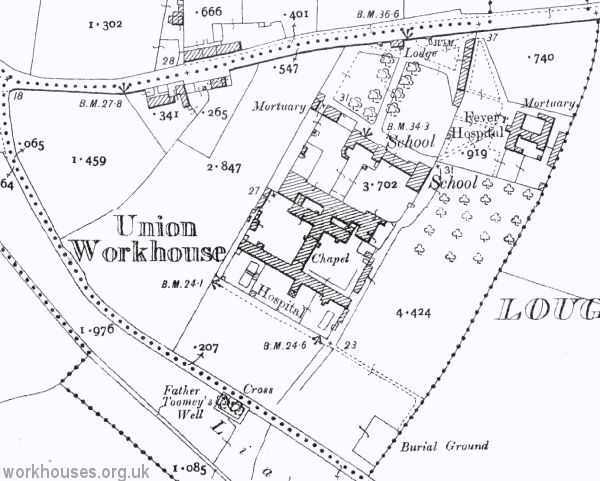
Dungarvan workhouse site, 1907
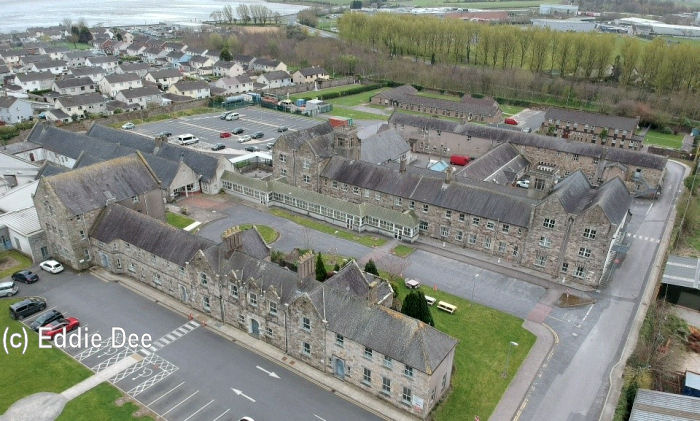
Dungarvan workhouse aerial view from the north-west.
© Eddie Dee.
The workhouse building followed one of the standard designs by the Poor Law Commission's architect George Wilkinson, with a two-storey entrance block at the front containing Guardians' board-room, clerk's office, probationary, vagrant and refractory wards. The entrance block was later extended at each side, the additional accommodation used to house children, school-rooms etc..
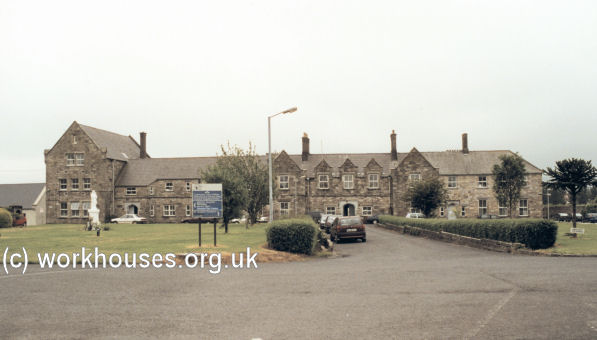
Dungarvan workhouse from the north, 2000.
© Peter Higginbotham.
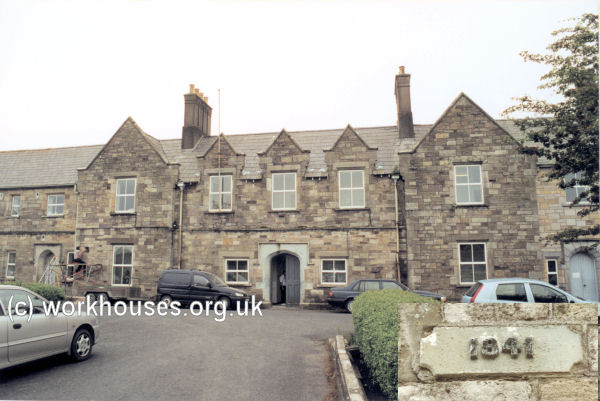
Dungarvan original section of entrance block from the north, 2000.
© Peter Higginbotham.
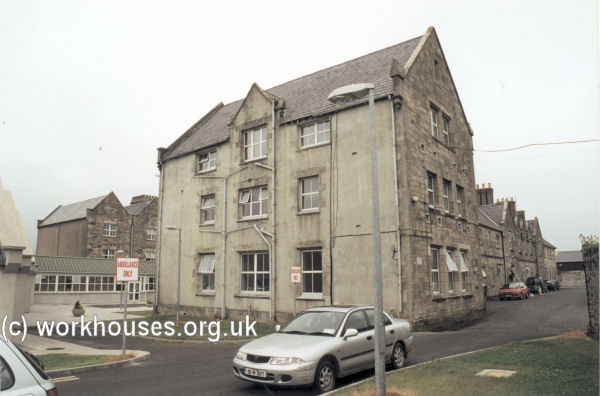
Dungarvan entrance/school block from the east, 2000.
© Peter Higginbotham.
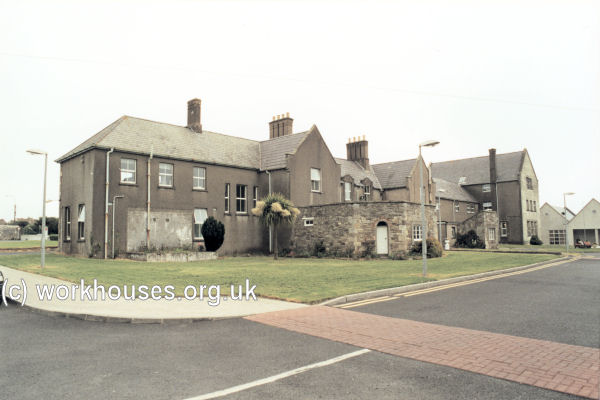
Dungarvan rear of entrance block from the west, 2000.
© Peter Higginbotham.
Behind the entrance block stood the long main block, two-storey for most of its length with three-storey blocks at each end. The central part contained the Master and Matron's accommodation with the boys' schoolrooms to the west and girls' to the east. Above the schoolrooms were the children's dormitories. The end blocks contained wards for the old and infirm.
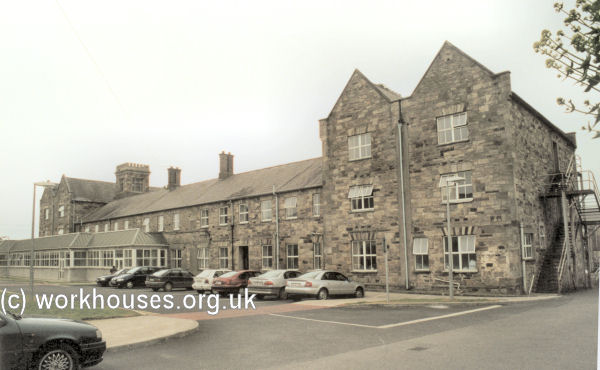
Dungarvan workhouse main block, 2000.
© Peter Higginbotham.
To the rear were kitchens and wash-houses, then a single-storey spine containing dining-hall and chapel led to the infirmary block and idiot wards.
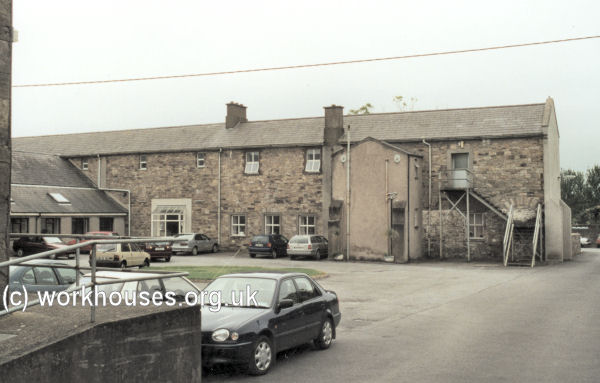
Dungarvan workhouse spine and infirmary block, 2000.
© Peter Higginbotham.
The Famine Years
Dungarvan, which was in a noted potato-growing area, suffered greatly during the famine years 1845-50. Following severe rises in food prices, the Dungarvan Relief Committee was established in January 1846, with the aim of distributing Indian-meal at subsidized prices. On 28th September 1846, the scarcity and price of food, and the shortage of work, resulted in the Dungarvan riots where grain stores on Dungarvan Quay were looted.
Pressure on the workhouse steadily increased, which had 650 inmates by 19th December 1846, rising to 739 by January 1st, and 766 by January 16th. Diseases such as typhus fever and dysentery were widespread. Attempt were made to reduce numbers by giving out-relief to the healthier inmates. A number of auxiliary workhouse buildings were set up. Government-sponsored soup-kitchens were set up during the first half of 1847, but the scheme ended in July. A few public-works schemes were also instigated. However, things got worse throughout 1847. What relief measures were proposed were hampered by lack of funds — rate-collectors found it very difficult to collect rates, and in some instances needed police protection.
In 1846, the guardians took over the Dungarvan fever hospital, which was at Strandside North, Abbeyside. In March 1847, a stable was converted to fever wards. The following month, the guardians decided to build two temporary sheds. These were 100 ft. long by 16 ft. wide, and located on the fever hospital grounds. They could accommodate 100 patients.
The misery continued through 1848 and into 1849. At the start of January 1849, the total number of workhouse inmates stood at 2,751 and rose to over 3,000 by the end of that month. At the start of February, the situation was compounded by the first cases of a cholera epidemic that would last for several months.
A new fever hospital was later erected at the north-east of the workhouse.
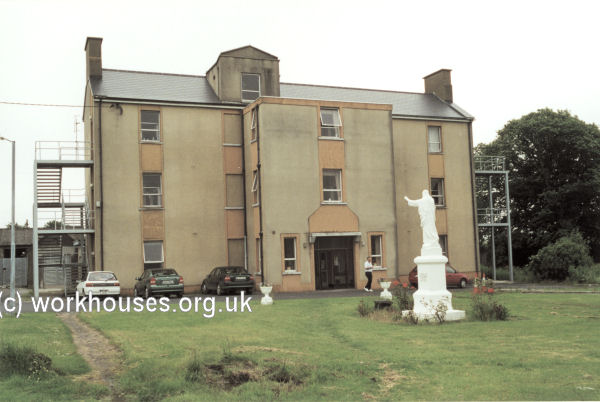
Dungarvan workhouse fever hospital block from the west, 2000.
© Peter Higginbotham.
Famine Graveyards
A stark reminder of the scale of the deaths during the famine years comes in the shape of the famine graveyards in which famine victims were buried in unmarked graves. From the end of 1847, the dead from Dungarvan workhouse went to the Slievegrine graveyard at Pulla. Prior to this, the old graveyard at Kilrush was used.
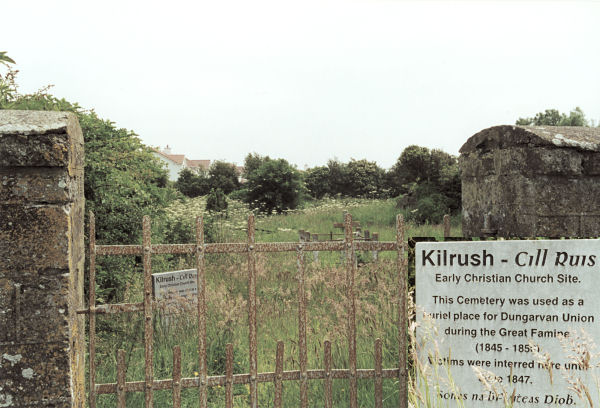
Kilrush famine graveyard, 2000.
© Peter Higginbotham.
Many of the original workhouse buildings survive in the shape of the present-day Dungarvan Community and St Joseph's Hospitals. Part of the entrance block is also used as the local Register Office.
Records
Note: many repositories impose a closure period of up to 100 years for records identifying individuals. Before travelling a long distance, always check that the records you want to consult will be available.
- Waterford County Archive Service, Dungarvan Central Library, Davitt's Quay, Dungarvan, Co. Waterford. Holdings include Board of Guardians' minutes (November 1845-1922) etc. Detailed description of surviving records.
Bibliography
- Desperate Haven by W Fraher, B Sheridan, S O Loingsigh, W Whelan. (1998. Republished 2020 Waterford County Museum Society. Paperback and ebook versions available Amazon.) Alternatively, contact history@waterfordmuseum.
- The Workhouses of Ireland by John O'Connor (Anvil Books, 1995)
Links
- Dungarvan Museum web site has many pages about the history of West Waterford including the local workhouse.
Unless otherwise indicated, this page () is copyright Peter Higginbotham. Contents may not be reproduced without permission.


